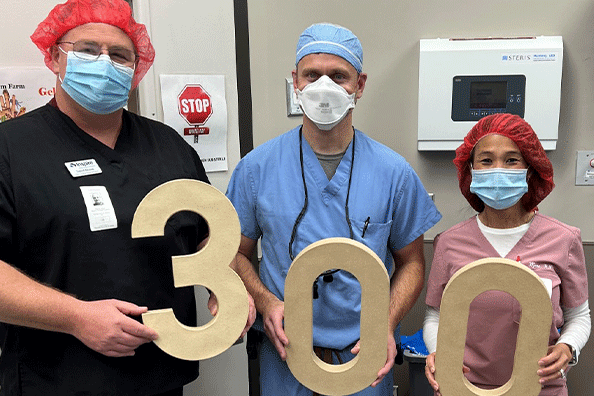 Kirk Withrow, M.D., performs 300th hypoglossal nerve stimulator implant procedure.
Kirk Withrow, M.D., performs 300th hypoglossal nerve stimulator implant procedure.
On April 21, Kirk Withrow, M.D., Associate Professor at UAB Department of Otolaryngology and Director of Salivary and Sleep Surgery, marked an important milestone in treating patients with obstructive sleep apnea (OSA). On this day, he implanted his 300th hypoglossal nerve stimulator, a significant accomplishment for Withrow, who was the first surgeon in Alabama to implant the Inspire device in 2015.
As his practice has grown exponentially, so has patient interest. It’s been an amazing journey from 2015 until the present, says Dr. Withrow, who has seen first-hand how this procedure has had numerous positive impacts on patients’ lives. “It’s very effective; more effective than other surgeries that involve far more morbidity,” Withrow said.
OSA affects approximately 22 million Americans. When left untreated, OSA can lead to automotive and workplace accidents, worsening mood and memory, stroke, heart attack, and even death. In many cases, Dr. Withrow reports, successful treatment of OSA allows patients simply to reclaim their lives. Withrow shares most patients treated with hypoglossal nerve stimulator see a normalization on the Epworth Sleepiness Scale (ESS), a tool that’s routinely used to assess the degree of daytime sleepiness.
The minimally invasive, outpatient procedure involves the subcutaneous placement of an FDA-approved nerve stimulator which bears resemblance to a cardiac pacemaker. Through stimulation of the hypoglossal nerve, muscle tone that is lost during normal sleep is restored, leading to airway opening and diminished airway obstruction. While the tongue receives the only direct stimulation, its attachment to other structures including the soft palate and epiglottis lead to significant effect at these levels as well. As such, the device achieves a broader upper airway stimulation in many instances.
While there are criteria related to BMI and severity of sleep apnea that patients must meet to qualify for this procedure, many patients will be suitable candidates, pending the results of a sleep endoscopy. Both sleep endoscopy and hypoglossal nerve implantation are routinely covered by insurance, and are generally associated with a mild recovery. “It takes me approximately an hour to do. There's very minimal recovery, minimal pain with it, certainly relative to our other [sleep apnea] surgeries,” Withrow said.
Dr. Withrow first began to look into this procedure after learning about the basic science research; he proactively reached out to the manufacturer of the device. No stranger to pioneering work, Withrow explores many ways to use his talents—both in and out of the OR. Just ask him about the numerous books he’s authored, his artwork, or rock climbing adventures. If you’re lucky, he may show you one of the guitars he creates from cigar boxes. It’s this pioneering spirit coupled with expert training that has allowed Withrow to persevere to find innovative ways to improve the lives of his patients with sleep apnea.
To learn more about the 300th hypoglossal nerve stimulator implant and how this procedure is used, tune in to Dr. Withrow’s Medcast.